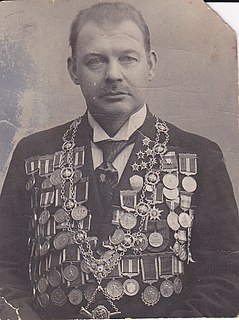
The International Shooting Sport Federation recognizes several shooting events, some of which have Olympic status. They are divided into four disciplines: rifle, pistol, shotgun and running target.

Pantelis Karasevdas was a Greek shooter. He was a member of Panachaikos Gymnastikos Syllogos, that merged in 1923 with Gymnastiki Etaireia Patron to become Panachaiki Gymnastiki Enosi. Karasevdas competed at the 1896 Summer Olympics in Athens, where he won a gold medal for the host country.

Anastasios Metaxas was a Greek architect and shooter.

Georgios Orphanidis was a Greek sports shooter. He competed at the 1896 Summer Olympics in Athens and at the 1908 Summer Olympics in London. He also competed at the 1906 Intercalated Games.
The men's 50 metre rifle three positions competition at the 2004 Summer Olympics was held on 22 August at the Markópoulo Olympic Shooting Centre near Athens, Greece.

The 300 m rifle three positions event was one of five free rifle events of the competitions in the Shooting at the 1900 Summer Olympics events in Paris. They were held from August 3 to August 5, 1900. 30 shooters from 6 nations competed, with five shooters per team. Medals were given for individual high scores in each of the three positions, overall individual high scores, and the scores of the five shooters were summed to give a team score. The three positions event was won by Emil Kellenberger of Switzerland. Paul Van Asbroeck of Belgium took silver, while Ole Østmo of Norway earned bronze.

The men's 200 metre military rifle event was one of five sport shooting events on the Shooting at the 1896 Summer Olympics programme. It was held at a distance of 200 metres, on 8 April and 9 April, with each shooter firing half of his shots on the first day and half the second. Shooters fired four strings of ten shots each, for a total of 40 shots. 42 shooters, representing each of the seven nations that had shooters in Athens, competed.

The men's 25 metre military pistol was one of the five sport shooting events on the 1896 Summer Olympics shooting programme. 16 competitors from four nations entered the military pistol match, held on 10 April. Each shot thirty rounds in five strings of six at a target 25 metres away. The winner, John Paine of the United States, hit the target 25 times. His brother, Sumner Paine, hit the target 23 times. They used American-made military Colt revolvers.

The 25 metre muzzle-loading pistol was one of the five sport shooting events on the 1896 Summer Olympics shooting programme. The armament of the American Paine brothers was disqualified because of not being "of the usual calibre" for the event. With the Paine brothers declining the offer of the Greek shooters to use their pistols, only four shooters entered the fourth shooting event. Three nations were represented. Each shooter fired five strings of six shots at a target 25 metres distant. The competition was held on 11 April and resulted in the top two places going to the Greek marksmen. Nielsen took third place and Merlin did not finish.

The men's "30 metre individual competition with free revolver" was one of the five sport shooting events on the 1896 Summer Olympics shooting program. Six competitors entered the pistol event on 11 April. Having won the 25 metre military pistol event, John Paine then withdrew from the 30 metre free pistol event, citing his desire to not embarrass his Greek hosts. He also said he had an agreement with his brother that whoever won the first event between them would drop out the next event. The competitors each shot five strings of six shots. Sumner Paine won the event.

The men's 300 m rifle three positions was one of 15 events on the shooting at the 1908 Summer Olympics programme. The competition was held on Saturday, 11 July 1908. Each nation could enter up to 12 shooters. Fifty-one sport shooters from ten nations competed. The event was won by Albert Helgerud of Norway, the nation's first victory in the event. Norway also won bronze, with Ole Sæther finishing third. Between the two Norwegians was Harry Simon, taking silver in the United States' debut.

The men's 300 m rifle three positions was a shooting sports event held as part of the shooting at the 1912 Summer Olympics programme. It was the third appearance of the event, which had been introduced in 1900. The competition was held on Tuesday, 2 July 1912. Eighty-four sport shooters from nine nations competed. The event was won by Paul Colas of France, the nation's first medal in the event. Denmark took the silver and bronze medals, as Lars Jørgen Madsen finished second and Niels Larsen placed third.

The men's 300 m rifle three positions was a shooting sports event held as part of the Shooting programs at the 1920 Summer Olympics programme. It was the fourth appearance of the 300 metre rifle three positions event at an Olympic Games. The competition was held on 31 July 1920, with 70 shooters from 14 nations competing. The event was won by Morris Fisher of the United States, the nation's first victory in the event. Niels Larsen of Denmark earned silver, while Østen Østensen of Norway took bronze.

The mixed 300 m rifle three positions was an event at the 1972 Summer Olympics. This was the final time that free rifle was contested at the Olympics. Soviet shooter Boris Melnik was leading 1155 to 1154 when the unofficial scores were posted, but the official scoring brought American Lones Wigger up to 1155, Wigger won the tie breaker with a better score on the last string fired kneeling, 97, versus 96 for Melnik. It was the third consecutive victory in the event for the United States; the Soviet Union had taken at least one medal each of the six times it competed before the event was discontinued. Lajos Papp of Hungary took bronze.

The men's 300 m rifle three positions was a shooting sports event held as part of the Shooting at the 1948 Summer Olympics programme. It was the fifth appearance of the event at an Olympic Games. The competition was held on 5 and 6 August 1948, with 36 shooters from 13 nations competing. Each nation was limited to three shooters. The event was won by Emil Grünig of Switzerland, the nation's first victory in the event since 1900 and second overall. Silver went to Pauli Janhonen of Finland and bronze to Willy Røgeberg of Norway.

The men's 300 m rifle three positions was a shooting sports event held as part of the Shooting at the 1952 Summer Olympics programme. It was the sixth appearance of the event at an Olympic Games. The competition was held on 27 July 1952, with 32 shooters from 18 nations competing. Each nation was limited to two shooters. The event was won by Anatoli Bogdanov with Lev Vainshtein in third, as the Soviet Union took both gold and bronze in its debut. Between the Soviets was Robert Bürchler of Switzerland, earning silver.

The men's 300 m rifle three positions was a shooting sports event held as part of the Shooting at the 1956 Summer Olympics programme. It was the seventh appearance of the event at an Olympic Games. The competition was held on 1 December 1956, with 20 shooters from 14 nations competing. Nations had been limited to two shooters each since the 1952 Games. The event was won by Vasily Borisov of the Soviet Union, the nation's second consecutive victory in two appearances. The Soviets finished 1–2, with Allan Erdman taking silver. Vilho Ylönen of Finland earned the bronze.

The men's 300 m rifle three positions was a shooting sports event held as part of the Shooting at the 1960 Summer Olympics programme. It was the eighth appearance of the event at an Olympic Games. The competition was held on 3 and 5 September 1960, with 39 shooters from 22 nations competing. Nations had been limited to two shooters each since the 1952 Games. The event was won by Hubert Hammerer in Austria's debut in the event. Hans Rudolf Spillmann of Switzerland took silver. Soviet Vasily Borisov was the second man to win two medals in the event, adding a bronze to his 1956 gold.

The men's 300 m rifle three positions was a shooting sports event held as part of the Shooting at the 1964 Summer Olympics programme. It was the ninth appearance of the event at an Olympic Games. The competition was held on 15 October 1964, with 30 shooters from 18 nations competing. Nations had been limited to two shooters each since the 1952 Games. The event was won by Gary Anderson of the United States, the nation's first victory in the event since 1920 and second overall. Both Americans made the podium, as Martin Gunnarsson took bronze. Shota Kveliashvili of the Soviet Union earned silver, extending the nation's podium streak to four Games.

The mixed 300 m rifle three positions was a shooting sports event held as part of the Shooting at the 1968 Summer Olympics programme. It was the 10th appearance of the event at an Olympic Games. The competition was held on 23 October 1968, with 30 shooters from 16 nations competing. Nations had been limited to two shooters each since the 1952 Games. The event was won by Gary Anderson of the United States, the only person to successfully defend an Olympic title in the event. It was the United States' third gold medal in the event, most of any nation. Valentin Kornev extended the Soviet Union's podium streak in the event to five Games with his silver. Swiss shooter Kurt Müller took bronze.















